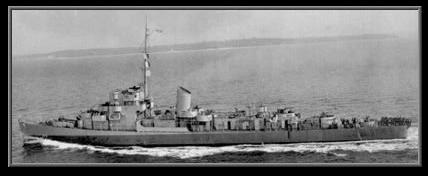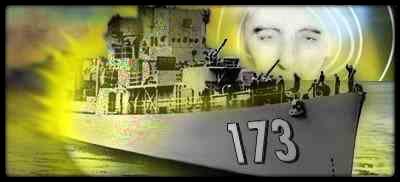


Janes Fighting Ships simply gives her as 'USS Eldridge' (DE-173) -1943. Some researchers state she was launched on 25 July 1943. Curiously, her log book from August to December 1943 is recorded as "missing and therefore unavailable".(*See note next paragraph.)
* Written on July 2, 2002: Janes Fighting Ships simply gives her as 'USS Eldridge' (DE-173) -1943. Some researchers state she was launched on 25 Judy 1943. Curiously, her log book from August to December 1943 is recorded as "missing and therefore unavailable". Not true, the deck logs (microfim or paper copies from it) can be ordered at the National Archives/College Park, 8601 Adelphi Road, College Park, MD 20740-6001, 55$ for 200 pages covering 27 August to 31 December 1943. The information, that these logs are no longer available stems from the Berliz/Moore book "The Philadelphia Experiment". The Hellenic Navy still reports the LEON (former Eldridge) with launching date 25 June 1943, so can be found in 'Jane's Fighting Ships' Volumes 1963 to 1985. Only the US Navy claims the date of launching as 25 July 1943. Makes you wonder ?

Project Rainbow was allegedly an experiment conducted upon a small destroyer escort ship during World War II, both in the Philadelphia Naval Yard and at sea; the goal was to make that ship invisible to enemy detection. The accounts vary as to whether the original idea was to achieve invisibility to enemy radar or whether the prize sought after was more profound: optical invisibility. Either way, it is commonly believed that the mechanism involved was the generation of an incredibly intense magnetic field around the ship, which would cause refraction or bending of light or radar waves around the ship, much like a mirage created by heated air over a road on a summer day. The legend goes on to say that the experiment was a complete success... except that the ship actually disappeared physically for a time, and then returned. They wanted to "cloak" the ship from view, but they got de-materialization and teleportation instead..
It has been claimed that the Philadelphia Experiment was partly an investigation into how Albert Einstein's "Unified Field Theory for Gravitation and Electricity" might be used to advantage in the development of electronic camouflage for ships at sea. Einstein allegedly published his Unified Theory around 1925-27 in German, in a Prussian scientific journal, but it was later withdrawn as incomplete. This research was aimed at using intense electromagnetic fields to mask a ship from incoming projectiles, mainly torpedoes. This was later extended to include a study of creating radar invisibility by a similar field in the air rather than in the water.
The story begins in June of 1943, with the U.S.S. Eldridge, DE (Destroyer Escort) 173, being fitted with tons of experimental electronic equipment. This included, according to one source, two massive generators of 75 KVA each, mounted where the forward gun turret would have been, distributing their power through four magnetic coils mounted on the deck. Three RF transmitters (2 megawatt CW each, mounted on the deck), three thousand '6L6' power amplifier tubes (used to drive the field coils of the two generators), special synchronizing and modulation circuits, and a host of other specialized hardware were employed to generate massive electromagnetic fields which, when properly configured, would be able to bend light and radio waves around the ship, thus making it invisible to enemy observers.
The experiment, said to have taken place at the Philadelphia Naval Yard and also at sea, took place on at least one occasion while in full view of the Merchant Marine ship S.S. Andrew Furuseth, and other observation ships. The Andrew Furuseth becomes significant because one of its crewmen is the source of most of the original material making up the PX legend. Carlos Allende, a.k.a. Carl Allen, wrote a series of strange letters to one Dr. Morris K. Jessup in the 1950's in which he described what he claims to have witnessed: at least one of the several phases of the Philadelphia Experiment.
At 0900 hours, on July 22nd, 1943, so the story goes, the power to the generators was turned on, and the massive electromagnetic fields started to build up. A greenish fog was seen to slowly envelop the ship, concealing it from view. Then the fog itself is said to have disappeared, taking the Eldridge with it, leaving only undisturbed water where the ship had been anchored only moments before.
The elite officers of the Navy and scientists involved gazed in awe at their greatest achievement: the ship and crew were not only radar invisible but invisible to the eye as well! Everything worked as planned, and about fifteen minutes later they ordered the men to shut down the generators. The greenish fog slowly reappeared, and the Eldridge began to dematerialize as the fog subsided, but it was evident to all that something had gone wrong.
When boarded by personnel from shore, the crew above deck were found to be disoriented and nauseous. The Navy removed the crew, and shortly after obtained another. In the end, the Navy decided that they only wanted radar invisibility, and the equipment was altered.
On the 28th of October in 1943, at 17:15, the final test on the Eldridge was performed. The electromagnetic field generators were turned on again, and the Eldridge became near-invisible; only a faint outline of the hull remained visible in the water. Everything was fine for the first few seconds, and then, in a blinding blue flash, the ship completely vanished. Within seconds it reappeared miles away, in Norfolk, Virginia, and was seen for several minutes. The Eldridge then disappeared from Norfolk as mysteriously as it had arrived, and reappeared back in Philadelphia Naval Yard. This time most of the sailors were violently sick. Some of the crew were simply "missing" never to return. Some went crazy, but, strangest of all, five men were fused to the metal in the ship's structure.
The men that survived were never the same again. Those that lived were discharged as "mentally unfit" for duty, regardless of their true condition.
So, what had begun as an experiment in electronic camouflage, ended up as an accidental teleportation of an entire ship and crew, to a distant location and back again, all in a matter of minutes!

The ship involved in the experiment was supposedly the USS Eldridge. Operational Archives has reviewed the deck log and war diary from Eldridge's commissioning on 27 August 1943 at the New York Navy Yard through December 1943. The following description of Eldridge's activities are summarized from the ship's war diary. After commissioning, Eldridge remained in New York and in the Long Island Sound until 16 September when it sailed to Bermuda. From 18 September, the ship was in the vicinity of Bermuda undergoing training and sea trials until 15 October when Eldridge left in a convoy for New York where the convoy entered on 18 October. Eldridge remained in New York harbor until 1 November when it was part of the escort for Convoy UGS-23 (New York Section). On 2 November the convoy entered Naval Operating Base, Norfolk. On 3 November, Eldridge and Convoy UGS-23 left for Casablanca where it arrived on 22 November. On 29 November, Eldridge left as one of escorts for Convoy GUS-22 and arrived with the convoy on 17 December at New York harbor. Eldridge remained in New York on availability training and in Block Island Sound until 31 December when it steamed to Norfolk with four other ships. During this time frame, Eldridge was never in Philadelphia.
Supposedly, the crew of the civilian merchant ship SS Andrew Furuseth observed the arrival via teleportation of the Eldridge into the Norfolk area. Andrew Furuseth's movement report cards are in the Tenth Fleet records in the custody of the Modern Military Branch, National Archives and Records Admnistration, (8601 Adelphi Road, College Park, MD 20740-6001), which also has custody of the action reports, war diaries and deck logs of all World War II Navy ships, including Eldridge. The movement report cards list the merchant ship's ports of call, the dates of the visit, and convoy designation, if any. The movement report card shows that Andrew Furuseth left Norfolk with Convoy UGS-15 on 16 August 1943 and arrived at Casablanca on 2 September. The ship left Casablanca on 19 September and arrived off Cape Henry on 4 October. Andrew Furuseth left Norfolk with Convoy UGS-22 on 25 October and arrived at Oran on 12 November. The ship remained in the Mediterranean until it returned with Convoy GUS-25 to Hampton Roads on 17 January 1944. The Archives has a letter from Lieutenant Junior Grade William S. Dodge, USNR, (Ret.), the Master of Andrew Furuseth in 1943, categorically denying that he or his crew observed any unusual event while in Norfolk. Eldridge and Andrew Furuseth were not even in Norfolk at the same time.
The Office of Naval Research (ONR) has stated that the use of force fields to make a ship and her crew invisible does not conform to known physical laws. ONR also claims that Dr. Albert Einstein's Unified Field Theory was never completed. During 1943-1944, Einstein was a part-time consultant with the Navy's Bureau of Ordnance, undertaking theoretical research on explosives and explosions. There is no indication that Einstein was involved in research relevant to invisibility or to teleportation. ONR's information sheet on the Philadelphia Experiment is attached.
The Philadelphia Experiment has also been called "Project Rainbow." A comprehensive search of the Archives has failed to identify records of a Project Rainbow relating to teleportation or making a ship disappear. In the 1940s, the code name RAINBOW was used to refer to the Rome-Berlin-Tokyo Axis. The RAINBOW plans were the war plans to defeat Italy, Germany and Japan. RAINBOW V, the plan in effect on 7 December 1941 when Japan attacked Pearl Harbor, was the plan the U.S. used to fight the Axis powers.
Some researchers have erroneously concluded that degaussing has a connection with making an object invisible. Degaussing is a process in which a system of electrical cables are installed around the circumference of ship's hull, running from bow to stern on both sides. A measured electrical current is passed through these cables to cancel out the ship's magnetic field. Degaussing equipment was installed in the hull of Navy ships and could be turned on whenever the ship was in waters that might contain magnetic mines, usually shallow waters in combat areas. It could be said that degaussing, correctly done, makes a ship "invisible" to the sensors of magnetic mines, but the ship remains visible to the human eye, radar, and underwater listening devices.
After many years of searching, the staff of the Operational Archives and independent researchers have not located any official documents that support the assertion that an invisibility or teleportation experiment involving a Navy ship occurred at Philadelphia or any other location.
28 November 2000